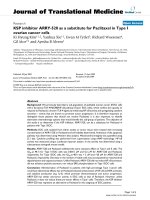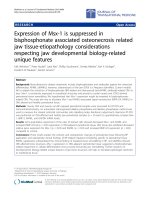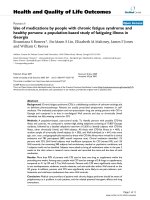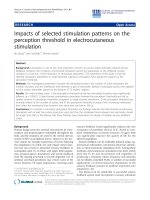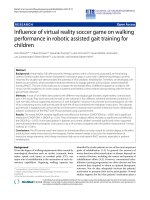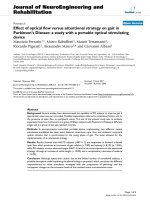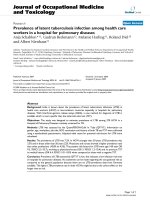báo cáo hóa học:" Use of Tranexamic acid is a cost effective method in preventing blood loss during and after total knee replacement" ppt
Bạn đang xem bản rút gọn của tài liệu. Xem và tải ngay bản đầy đủ của tài liệu tại đây (764.63 KB, 5 trang )
RESEARCH ARTICLE Open Access
Use of Tranexamic acid is a cost effective
method in preventing blood loss during and
after total knee replacement
Yasir J Sepah
1
, Masood Umer
2*
, Tashfeen Ahmad
3
, Faria Nasim
1
, Muhammad Umer Chaudhry
1
and
Muhammad Umar
4
Abstract
Background & Purpose: Allogenic blood transfusion in elective orthopaedic surgery is best avoided owing to
its associated risks. Total knee replacement often requires blood transfusion, more so when bilateral surgery is
performed. Many strategies are currently being employed to reduce the amount of peri-operative allogenic
transfusions. Anti-fibrinolytic compounds such as aminocaproic acid and tranexamic acid have been used
systemically in perioperative settings with promising results. This study aimed to evaluate the effectiveness of
tranexamic acid in reducing allogenic blood transfusion in total knee replacement surgery.
Methodology: This was a retrospective cohort study conducted on patients undergoing total knee replacement
during the time period November 2005 to November 2008. Study population was 99 patients, of which
70 underwent unilateral and 29 bilateral knee replacement. Forty-seven patients with 62 (49.5%) knees (group-I)
had received tranexamic acid (by surgeon preference) while the remaining fifty-two patients wi th 66 (51.5%)
knees (group-II) had did not receiv ed any tranexamic acid either pre- or post-operatively.
Results: The mean drop in the post-operative haemoglobin concentration in Group-II for unilateral and bilateral
cases was 1.79 gm/dl and 2.21 gm/dl, with a mean post-operative drainage of 1828 ml (unilateral) and 2695 ml
(bilateral). In comparison, the mean drop in the post-op haemoglob in in Group-I was 1.49 gm/dl (unilateral) and
1.94 gm/dl (bilateral), with a mean drainage of 826 ml (unilateral) and 1288 ml (bilateral) (p-value < 0.001).
Interpretation: Tranexamic acid is effective in reducing post-operative drainage and requirement of blood
transfusion after knee replacement.
Introduction
Total knee replacement is a frequently done procedure
in modern day practice of any Orthopedics unit. Limit-
ing blood loss both postoperatively and intra-operatively
presents a challenge to the surgeon. Postoperatively,
blood continues to ooze from the cut ends of bone, the
open intra-medullary canal and the raw, dissected soft
tissues. This can amount to significant bleeding with
figures ranging from 600 - 1500 ml [1-7]. As this proce-
dure is performed under tourniquet control, there is an
associated increase in localized fibrinolysis, which
contributes to two events. Firstly, it decreases the risk of
venous thromboembolism and secondly it may aggravate
post-operative haemorrhage [8-10]. The pro blem of
excessive blood loss i s further highl ighted in cases of
simultaneous bilateral total knee replacement where
blood loss i s usually twice that of a unilateral knee
replacement and the number of allogenic blood units
transfused can be as high as three to four per person
[11,12]. Risks associated with allogenic blood transfusion
are numerous and well documented. Of these the most
important are blood borne infections, immunological
reactions and cost incurred in producing a unit of red
cells [13-15].
Tranexamic acid is an antifibrinolytic agent, which
effectively blocks this fibrinoly tic activity, thus causing a
* Correspondence:
2
Associate Professor Department of Surgery (Orthopedics) Aga Khan
University Hospital, Karachi-74800, Pakistan
Full list of author information is available at the end of the article
Sepah et al. Journal of Orthopaedic Surgery and Research 2011, 6:22
/>© 2011 Sepah et al; licensee BioMed Central Ltd. Thi s is an Open Access article distributed under the terms of the Creative Commons
Attribution License ( which permits unrestricted use, distribution, and reproduction in
any medium, provided the original work is properly cited.
marked reduction in post-operative bleeding. It works
by blocking the lysine binding sites of plasminogen and
prevents the degradation of fibrin. It has been previously
used quite successfully in urological, gynecological and
thoracic surgical procedures in order to reduce post-
operative blood loss [16-19]. The use of tranexamic acid
in orthopedic surgery has also shown promising results.
It radically reduced both blood loss and the amount of
allogenic transfusions needed postoperatively [9,20-22].
Considering the high risks associated with the use of
allogenic blood, we think that this drug ca n be very
beneficial to patients undergoing both unilateral and
simultaneous bilateral total knee replacements.
■ The aim of this study was to determine: if the use
of tranexamic acid reduces perioperative blood loss
and need for allogenic blood transfusion in patients
undergoing total knee replacement
■ Any untoward effects with the use of this drug in
our population
Materials and methods
All patients having undergone total knee replacement at
our hospital between November 2005 to November
2008 were included in the study sample.
A total of 99 patients with 128 knee joints were
included in the study. Patients from Group I received
one gram of IV tranexamic acid before inflation of the
tourniquet and 1 g af ter deflation of tourniquet. Sixty-
six patients (66.4%) underwent unilateral and 23 patients
(24.6%) had bilateral procedures.
All patients with no known bleeding disorders who
under-went TKR were included in our study. All
patients were given routine DVT prophylaxis with Injec-
tion Enoxaparin 40 mg subcutaneous once a day. Anaes-
thesia was standardized and all patients received
epidural anaesthesia according to standard practice.
Patients receiving chronic anticoagulants were excluded
from the study. Haemoglobin was measured preopera-
tively, one hour postoperatively and at 72 hours post-
operatively. The same surgical team performed a ll
procedures and the same implant (IB-II - Zimmer, War-
saw, IN) was used in all patients. Patellar replacement
was performed in all cases and all components were
cemented.
The established practice of transfusion in our
unit is that patients are transfused if:
1. Postoperative Hb is < 7 mg/dl in patients with no
coronary heart disease, or < 9 mg/dl in patients who
have coronary heart disease
2. Physiological signs of inadequate oxygenation suc h
as hemodynamic instability or symptoms of myocardial
ischemia occur
3. Drainage of more than 1 liter of blood in the first
24 hours
47 patients with 32 (68%) undergoing a unilateral and
15 (32%) undergoing simultaneous bilateral total knee
replacement had received tranexamic acid and these
were labelled as Group-I. Data form Group-I was col-
lected retrospectively by chart review and then com-
pared with that of Group-II which was a historical
control group. Group-II underwent the same procedure
of either a unilateral or simultaneous bilateral total knee
replacements, but did not receive tranexamic acid and
also did not undergo any other procedure to reduce
post-operative bleeding. Patients in bo th groups were
age and disease-ma tched. There were 52 patients in
Group-II with 38 (76%) undergoing a unilateral and
14 (24%) undergoing a simultaneous bilateral knee
replacement procedure.
Student t-test was used to compare the means via
SPSS 13.
Results
Mean age of our study population was 59 years [Figure 1].
70% were females and 30% were male patients. Indication
for surgery in 71% of the patients was osteoarthritis while
in 29% of the patients it was rheumatoid arthritis.
The mean drop in the post-operative haemoglobin con-
centration unilateral surgery was 1.49 gm/dl in group Ii
and 1.79 gm/dl in group II, a difference of 17%. for bilat-
eral surgery, the d rop was 1.94 gm/dl and 2.21 gm/dl
respectively, a difference of 12%. mean postoperative
blood drainage in unilateral surgery was 826 ml and 1828
ml respectively, a difference of 55%, while in bilateral sur-
gery it was 1288 ml and 2695 ml respectively, a difference
of 52%. Mean drop in the pos t-operative haemoglo bin
concentration and mean post-operative drainage of both
Group-I and Group-II is given in Table 1. Thirty-nine
(75%) out of 52 patients in this Group-II required transfu-
sion. Thirty-two (61.53%) patients required one or two
Figure 1 Age groups.
Sepah et al. Journal of Orthopaedic Surgery and Research 2011, 6:22
/>Page 2 of 5
units of packed red cells and seven (13.46%) patients
required more than two units of transfusion in this group.
In comparison, only 6 (12.76%) out of the 47 patients in
Group-I required blood transfusion and remaining 22
(88.24%) had not required any transfusion. This difference
between the two groups in the number of units of blood
transfused is statistically significant (p-value < 0.001). A
statistically significant (p-value < 0.01) difference in trans-
fusion requirement for patients with Osteoarthritis and
Rheumatoid Arthritis was also noted [Figure 2]. No unto-
ward side effect of tranexamic acid was noted in our
patients.
Discussion
Knowing all the risks and morbidity associated with
allogenic blood transfusion, a surgeon always looks for
ways and means whereby a llogenic blood transfusion
can be avoided in surgical patients. The most noticeable,
and extensively explored options available are preopera-
tive blood donatio n (PAD), acute normovolemic hemo-
diluti on (ANH), perioperati ve red cell salvage (PCS) and
certain anaesthetic techniques (deliberate hypotension,
normothermia) [23]. Certain pharmacological interven-
tions that have been used with su ccess are Recombinant
Human Erythropoietin, tranexamic acid and Aprotinin.
However, none of these agents are without complica-
tions [table 2] and the most important factors to con-
sider in the developing world are the availability and
cost effectiveness of these strategies.
Tranexamic acid, by way of its anti-fibrinolytic action,
prevents clot breakdown and a consequent re-bleed.
Our results demonstrate significant reduction in blood
loss with the use of tranexamic acid. Other studies have
also had similar results [20,22]. A meta analysis which
looked at double blinded randomized controlled trial
also found that tranexamic acid was useful in reducing
blood loss in major orthopedic procedures [24].
No adverse effects were seen in our population with the
use of tranexamic acid. Although side effects have been
reported in other large scale studies but none of them
were serious enough to warrant disuse of the drug [25,26].
In South Asia, apart from p overty, low literacy, social
factors that result in the inability of women to negotiate
safe sex, intravenous drug use and unsafe transfusion is
regarded as one of the most important factors that
Table 1 Summary of results
Mean Post-Operative
Drainage
Mean Drop in
Post-Operative HB
Mean number of Packed
Cells Transfused
Number of Patients
requiring Transfusion
Unilateral Bilateral Unilateral Bilateral Unilateral Bilateral
Group-I (N = 47) 826 ml 1288 ml 1.49 g/dl 1.94 g/dl 0.12 0.9 6
Group-II (N = 52) 1828 ml 2695 ml 1.79 g/dl 2.21 g/dl 1.24 2.6 35
p value < 0.001 < 0.001 0.0005 < 0.0005 0.005 0.043
Figure 2 Comparison of transfusion requirement in
Osteoarthritis & Rheumatoid arthritis.
Table 2 Different methods of blood conservation and
their complications
Alternatives used to avoid allogenic blood transfusions and their
disadvantages
Preoperative Blood
Donation (PAD)
• Cardiac, Vasovagal (Risk Factors: Younger
Age, Lower weight, 1
St
time donation) [34]
• 12 times increase in Anginal and
Vasovagal complications (Risk Factor: 1
st
time donation) [35]
• Overall increase frequency of transfusion
(Risk Factor: Lower Preoperative Hematocrit)
[36,37]
• Not Cost Effective in Orthopaedic
Procedures [38](More expensive to produce
one unit of autologous blood, Cost also
incurred in disposal of more than half of the
blood discarded which is not used)
Acute Normovolemic
Hemodilution (ANH)
Not effective in Orthopedic Procedures
(data termed inconclusive) [39]
Perioperative red cell
salvage (PCS)
Cost effectiveness of the postoperative
blood collection devices was challenged
(1
st
six hour collection would cost 31-35
million dollars) [40]
Deliberate Hypotension
DH)
Persistent hypotension, Reactionary
haemorrhage, Cardiac Ischemic Injury,
Ischemic Optic neuritis [41-43]
Recombinant Human
Erythropoietin (RHE)
Routine use not justified due to high cost
[44]
Tranexamic acid Very effective [9,20]
Aprotinin • Low dose not effective in orthopedic
procedure [45]
• Evidence has been published to suggest
an increase in renal events in patients
given aprotinin when compared to those
where tranexamic acid was used [46]
Sepah et al. Journal of Orthopaedic Surgery and Research 2011, 6:22
/>Page 3 of 5
influence transmission of infection [27,28]. High fre-
quency of viremia due to transfusion-t ransmitted virus
was observed in most of the stu dy populations from
third world countries, with values ranging from 16 per-
cent in Pakistan to 83 percent in Gambia [29]
A large scale study [30] in Pakistan has shown that the
screening coverage on the average has been 77.42% for
HIV and 86.84% for HBV. The prevalence of HIV is
0.001% and of HBV is 2.259% [30]. The probability of
receiving an infective unit P(R) per 10000 donations is
0.023 for HIV and 29.72 for HBV. The probability of
transmitting infection P (I) per 10000 donations is 0.021
for HIV and 26.75 for HBV. The spreading index for
both viral infections combined is 26.75 per 10000 dona-
tions. Although 80% of joint replacement procedures
take place in the United States and Europe, South Asia
is not far behind with an estimated 40-50 thousand joint
replacement procedures already done yearly in India
alone [31]. Number of knees replaced annually in Paki-
stan is estimated to be 1500-2000 [32].
The cost of one unit of red cells is estimated 120
pounds [14] in Britain while it costs 19.20 British
Pounds in Pakistan [33]. The regimen of tranexamic
acid that was administered in our study population costs
3.75 Pounds. These figures reflect that if one is able to
decrease the requirement of blood by even o ne unit per
patient the cumulative effect will be a decrease of bur-
den on the health care system. Countries where indivi-
duals pay for their own health care and there is no third
party plan (health insura nce companies) involved c an
benefit from adopting such cost effective measures.
Although we conducted a retrospect ive analysis of a
relatively small number patients and the possibility of
the results being affected by recall bias due to historical
controlscannotberuledoutitdoesprovidethebasis
for conducting larger scale prospective randomized stu-
dies in order to determine the efficacy of tranxemic acid
in reducing perioperative blood loss.
We believe that the use of t ranexamic acid in TKR
surgery is a low cost option in reducing the requirement
of allogenic blood transfusion.
Author details
1
Aga Khan University Medical College, Karachi-74800, Pakistan.
2
Associate
Professor Department of Surgery (Orthopedics) Aga Khan University Hospital,
Karachi-74800, Pakistan.
3
Assistant Professor Department of Surgery
(Orthopedics) Aga Khan University Hospital, Karachi-74800, Pakistan.
4
Professor Department of Surgery (Orthopedics) Aga Khan University
Hospital, Karachi-74800, Pakistan.
Authors’ contributions
YJS did the overall supervision and participated in the conception of the
idea, preparation of the questionnaire and protocol, collection of data and
writing the manuscript. MU was involved in the overall supervision,
preparation of the questionnaire and collection and analysis of data. TA was
involved in the study design, analysis and was involved in critically
reviewing the manuscript. FA and MUC participated in the designed the
study and participated in the preparation of the protocol and data
collection. MU participated in overall supervision and critically reviewed the
manuscript. All authors read and approved the final manuscript.
Competing interests
The authors declare that they have no competing interests.
Received: 13 October 2010 Accepted: 21 May 2011
Published: 21 May 2011
References
1. Cushner FD, F R: Blood loss in total knee arthroplasty. Clin Orth 1991,
269:98-101.
2. Fragen RJ, S S, Wixson R, et al: Effect of Ketorolac tromethamine on
bleeding and requirements for analgesia after total knee arthroplasty. J
Bone Joint Surg(Am) 1995, 77:998-1002.
3. Bukart BC, B R, Rorabeck CH, et al: The efficacy of tourniquet release in
blood conservation after total knee replacement. Clin Orth 1994,
299:147-52.
4. Karnezis TA, S S, Wixson RL, Reilly P: The hemostatic effects of
desmopressin on patients who had total joint arthroplasty. J Bone Joint
Surg(Am) 1994, 76:1545-50.
5. Mylod AG, F M, Muser DE, Parsons JR: Perioperative blood loss associated
with total knee arthroplasty. J Bone Joint Surg(Am) 1990, 72:1010-2.
6. Fauno P, S O, Rehnberg V, et al: Prophylaxis for the preventiopn of
venous thromboembolism after total knee arthroplasty. J Bone Joint Surg
(Am) 1994, 76:1814-8.
7. Goodnough LT, V D, Marcus RE: The relationship between hematocrit,
blood lost and blood transfused in total knee replacement. Am J Knee
Surg 1995, 8:83-7.
8. Klenerman L, M I, Chakrabarti R, et al: Changes in the hemostatic system
after application of a tourniquet. Lancet 1977, I:970-2.
9. Benoni G, C A, Petersson C, Fredin H: Does Tranexamic Acid reduces
blood loss after total knee arthroplasty? Am J Knee Surg 1995, 8:88-92.
10. Petaja J, M P, Myllyla G, Vahtera E: Fibrinolysis after application of a
pnematic tourniquet. Acta Chir Scand 1987, 153:647-51.
11. Martin JW, W L, Milliano MT, Reedy ME: Post operative blood Retrieval
and transfusion in cementless total knee arthroplasty. J Arthroplasty 1992,
7:205-10.
12. Lane GJ, H W, Shah S, Rothman RH, Booth RE Jr, Engh K, Smith P:
Simultaneous bilateral versus unilateral total knee replacement
arthroplasty. Outcomes Analysis. Clin Orthop 1997, 345:106-12.
13. Nozoe Tadahiro, M M, Saeki Hiroshi, Ohga Takefumi, Keizo Sugimachi:
Significance of allogenic blood transfusion on decreased survival in
patients with esophageal carcinoma. Cancer 2001, 92(7):1913-18.
14. Brian McClelland MC: Appropriateness
and safety of blood transfusion.
BMJ 2005, 330:104-105.
15. Spanh DR, C M: Eliminating blood transfusions. New aspects and
perspectives. Anesthesiology 2000, 93:242-55.
16. P O, H : Antifibrinolytic therapy with Cyklopropan in connection with
prostatectomy: a double blind study. Scand J Urol Nephrol 1969, 3:177-82.
17. Dunn CJ, G K: Tranexamic Acid: a review of its use in surgery and other
indications. Drugs 1999, 57:1005-32.
18. Bekasssy Z, A B: Treatment with fibrinolytic inhibitor tranexamic acid: risk
for thrombosis? Acta Obstet Gynecol Scand 1990, 69:353-4.
19. Kataros D, P M, Snow NJ, Woodland DD, Van Bergan : Tranexamic Acid
reduces postbypass blood loss: a double blinded, prospective,
randomised study of 210 patients. Ann Thorac Surg 1996, 61:1131-5.
20. Hiippala ST, S L, Wennerstrand MI, Arvela JV, Niemel a HM, M antyl a SK,
Kuisma RP, Ylinen JE: Tranexamic Acid radically reduces blood loss and
transfusions associated with total knee arthroplasty. Anesth Analg 1997,
84:839-44.
21. Hiippala S, S L, Wennerstrand M: Tranexamic Acid (Cyklopropan) reduces
perioperative blood loss associated with total knee arthroplasty. Br J
Anesth 1995, 74:534-7.
22. Benoni G, G H: Fibrinolytic inhibition with tranexamic acid reduces blood
loss and blood transfusion after knee arthroplasty: A prospective,
randomized, double blind study of 86 patients. J Bone Joint Surg Br 1996,
78:434-440.
23. Rosenblatt MA: Strategies for minimizing the use of allogeneic blood
during orthopedic surgery. Mt Sinai J Med 2002, 69(1-2):83-7.
Sepah et al. Journal of Orthopaedic Surgery and Research 2011, 6:22
/>Page 4 of 5
24. Zufferey Paul, F M, Laporte Silvy, Decousus Herve’, Mismetti Patrick,
Auboyer Christian, Charles Marc Samama, Molliex Serge: Do
Antifibrinolytics Reduce Allogeneic Blood Transfusion in Orthopedic
Surgery? Anesthesiology 2006, 105:1034-46.
25. Ip , P P, et al: Tranexamic acid-associated necrosis and intralesional
thrombosis of uterine leiomyomas: a clinicopathologic study of 147
cases emphasizing the importance of drug-induced necrosis and early
infarcts in leiomyomas. Am J Surg Pathol 2007, 31(8):1215-24.
26. Sethna NF, et al: Tranexamic acid reduces intraoperative blood loss in
pediatric patients undergoing scoliosis surgery. Anesthesiology 2005,
102(4):727-32.
27. Chrishantha Abeysenaa HJdS: HIV in South Asia. Medicine 2005, 33(6):42-43.
28. Ali S, T W, Khan A: Viral hepatitis in children. AFIP Rawalpindi, Pakistan;
1998.
29. Linda E, Prescott PS: Global Distribution of Transfusion-Transmitted Virus.
NEJM 1998, 339(11):776-777.
30. Mahfooz ur Rahman AGN, Lodhi Y: Transfusion transmitted HIV &
HBV infections in Punjab, Pakista. Pakistan Journal of Medical Sciences
2002, 18(1):18-25.
31. Mukherjee Rupali T: India to be largest market for knee, hip replacements.,
in The Times of India. 2007.
32. Sons Fa: Number of total knee implants supplied to Pakitan. Karachi;
2007.
33. Aga Khan University Hospital Karachi, Pakistan. Price list. [http://www.
aku.edu/AKUH/Patient_Visitor/page6.shtml].
34. Gandini G, et al: Preoperative autologous blood donation by 1073 elderly
patients undergoing elective surgery: a safe and effective practice.
Transfusion 1999, 39(2):174-8.
35. Trouern-Trend JJ, et al: A case-controlled multicenter study of vasovagal
reactions in blood donors: influence of sex, age, donation status, weight,
blood pressure, and pulse. Transfusion 1999, 39(3):316-20.
36. Forgie MA, et al: Preoperative autologous donation decreases allogeneic
transfusion but increases exposure to all red blood cell transfusion:
results of a meta-analysis. International Study of Perioperative
Transfusion (ISPOT) Investigators. Arch Intern Med 1998, 158(6):610-6.
37. Sculco TP, Gallina J: Blood management experience: relationship
between autologous blood donation and transfusion in orthopedic
surgery. Orthopedics 1999, 22(Suppl 1)
:s129-34.
38. Etchason J, et al: The cost effectiveness of preoperative autologous
blood donations. N Engl J Med 1995, 332(11):719-24.
39. Bryson GL, Laupacis A, Wells GA: Does acute normovolemic hemodilution
reduce perioperative allogeneic transfusion? A meta-analysis. The
International Study of Perioperative Transfusion. Anesth Analg 1998,
86(1):9-15.
40. Umlas J, et al: Red cell loss following orthopedic surgery: the case
against postoperative blood salvage. Transfusion 1994, 34(5):402-6.
41. Lee AG: Ischemic optic neuropathy following lumbar spine surgery. Case
report. J Neurosurg 1995, 83(2):348-9.
42. Stevens WR, et al: Ophthalmic complications after spinal surgery. Spine
(Phila Pa 1976) 1997, 22(12):1319-24.
43. James ML, Keifer JC: Posterior optic nerve ischemic neuropathy in the
setting of phenoxybenzamine therapy after uneventful spinal fusion. J
Neurosurg Anesthesiol 2011, 23(2):169-70.
44. Coyle D, et al: Economic analysis of erythropoietin use in orthopaedic
surgery. Transfus Med 1999, 9(1):21-30.
45. Kasper SM, et al: A retrospective study of the effects of small-dose
aprotinin on blood loss and transfusion needs during total hip
arthroplasty. Eur J Anaesthesiol 1998, 15(6):669-75.
46. Royston D, van Haaften N, De Vooght P: Aprotinin; friend or foe? A review
of recent medical literature. Eur J Anaesthesiol 2007, 24(1):6-14.
doi:10.1186/1749-799X-6-22
Cite this article as: Sepah et al.: Use of Tranexamic acid is a cost
effective method in preventing blood loss during and after total knee
replacement. Journal of Orthopaedic Surgery and Research 2011 6:22.
Submit your next manuscript to BioMed Central
and take full advantage of:
• Convenient online submission
• Thorough peer review
• No space constraints or color figure charges
• Immediate publication on acceptance
• Inclusion in PubMed, CAS, Scopus and Google Scholar
• Research which is freely available for redistribution
Submit your manuscript at
www.biomedcentral.com/submit
Sepah et al. Journal of Orthopaedic Surgery and Research 2011, 6:22
/>Page 5 of 5

